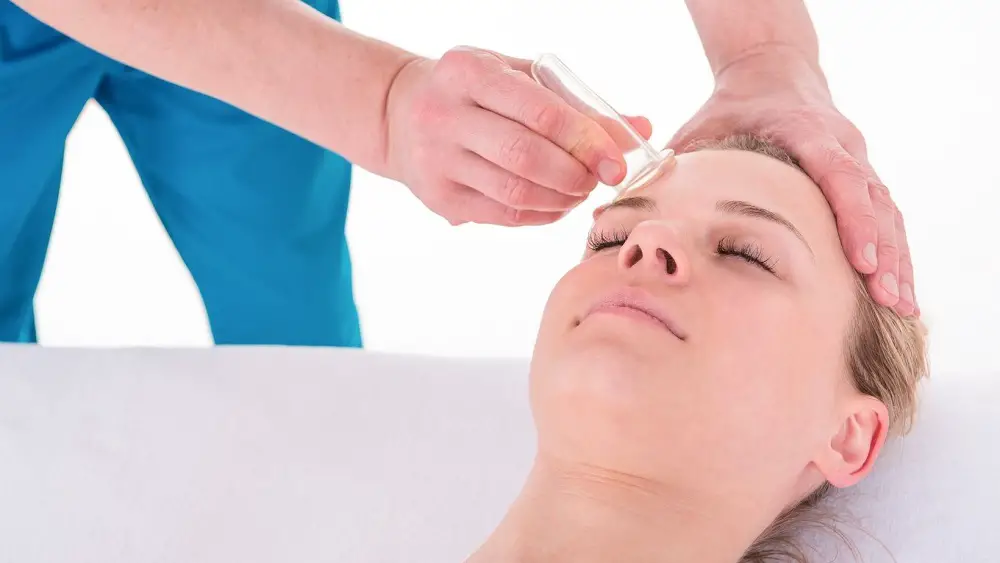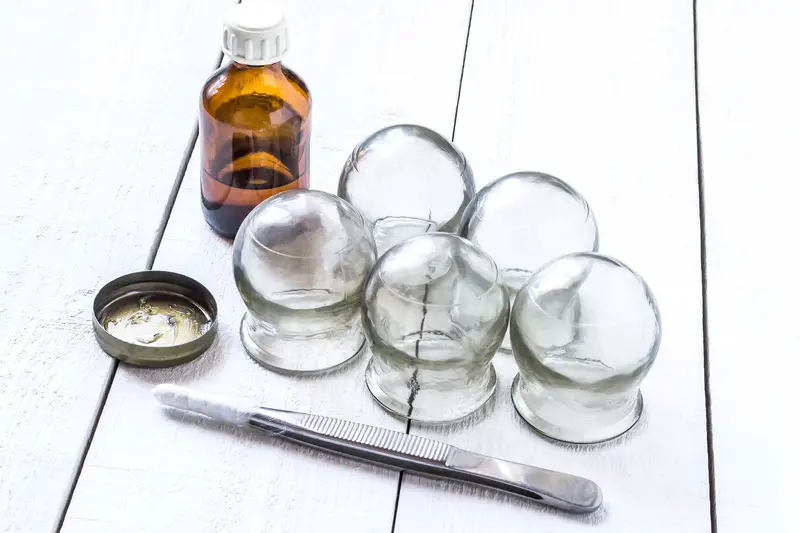If you’re looking for a cupping color chart along with an explanation of all the colors and skin reactions that happen after the session, you’re in for a treat! For thousands of years, people have been using cupping as an alternative therapy method for alleviating stress, body aches, and more.
Up to this day, a lot of Olympic and professional athletes still count on the ancient technique to recover and recuperate. The best thing about the technique is that it gives you instant pleasant relief right after the session. However, it’s also famous for its bruise-like marks that vary in colors. Read on if you want to know why these marks occur and what they mean?
What Is Cupping?
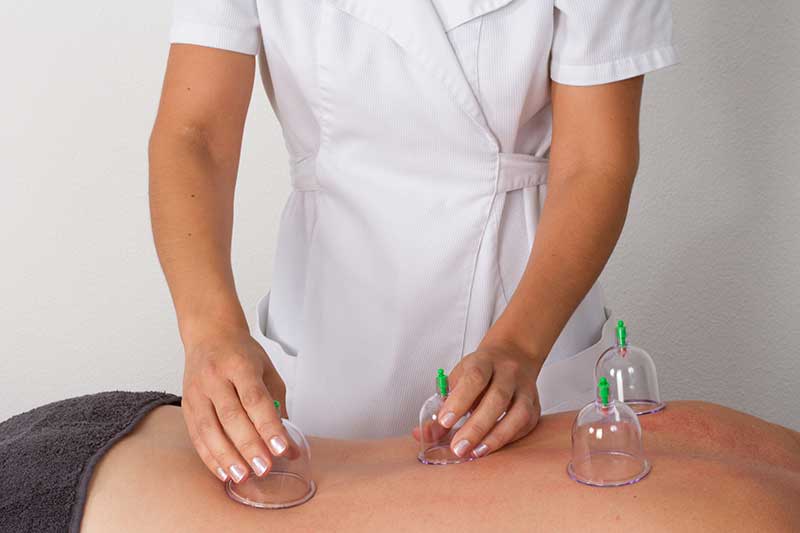
Before diving into the juicy details of the cupping marks, let’s define what cupping therapy is and how it works. As you know, Traditional Chinese Medicine (TCM) is all about the proper flow of inner energy, which it calls “qi” or “chi”. That’s where a lot of alternative physical therapy methods originated, such as acupuncture and cupping. In massage and acupuncture, the therapist applies pressure on the skin to reach the superficial layer of muscles in the body. On the other hand, cupping is an alternate therapy method that involves applying suction on different parts of the body. The suction is applied using special cups that are designed for that purpose, which is where the method got its name. The healer sanitizes the skin, then places a candle over a specific part of the body and then puts these glass jars over the candle. This creates a negative pressure that draws the skin up into the cups, creating a pleasant and relaxing sensation.
Cupping is composed of different methods with various techniques. For example, some of them are just left for about 5 to 10 minutes, while other therapists might start gliding the cups over different parts of the body.
Why Does Cupping Leave Marks?
Cupping, in general, is regarded as a relatively safe practice. Almost all studies conducted on that aspect proved that cupping is a beneficial alternative therapy technique. Despite all the good merits of cupping, it still has some flaws. Just like any therapeutic technique, cupping has some side effects that show after the session is finished.
The most common side effect of cupping therapy is the presence of cupping marks and the discoloration of the skin. The bruising of the skin is regarded as a part of the therapy session in many cases. There are two common explanations for the marks that are left behind after the cupping therapy. The more obvious one lies in the blood circulation. When the negative pressure is applied in the cups, and the skin is drawn up, a lot of the tiny blood capillaries in the superficial layer of muscles and skin are broken. This drives the body to treat the area as a bruise and start a bruise healing process. This process causes the discoloration of the skin by producing chemicals known as inflammatory mediators and by forming tiny blot clots under the skin. The other reason for cupping to leave marks is a bit tricker. When suction occurs, the gap between the skin layers increases. This extra space allows the tissues to collect more fluids, toxins, and dead cellular debris under the top layer of the skin. As the lymphatic system washes this debris away, the skin returns to its original color.
That’s why you shouldn’t worry about these marks. In fact, even ancient healers considered these bruises an indication of the success of the therapy session. The reason behind that is that they believed that these dark marks represent the release of the toxins from the body, which is close to the debris theory. They also believed that the darker these marks are, the more stagnation and toxin-filled the blood was.
There are other side effects that you can experience after cupping therapy. These are mainly minor dizziness and headaches.
There are also some side effects that occur due to practicing cupping therapy with an experienced therapist. These include pain and discomfort. That’s why you should always let the cupping therapist know if you’re uncomfortable or in pain during the session.
Cupping Color Chart
Now that you know the reason behind the colors of the cupping marks, it’s time to find out more about these colors. Let’s have a quick overview of each color that you might find along with its possible explanations.
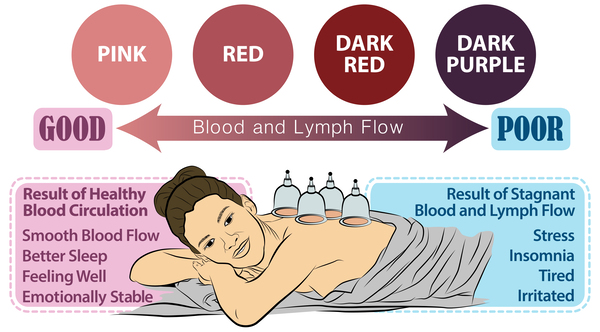
Light to Medium Pink Color
One of the most common outcomes of cupping therapy should lie within the range of pinkish colors. According to the severity of the pink color, this indicates anywhere between a healthy body with little to no toxins to very mild stagnation. In most cases, the color reaches its peak in 4 to 5 days and starts to disappear afterward as the body washes it away and heals the scars.
Since these colors indicate a low level of toxins, they’re common among regular and frequent cupping patients, as the toxins don’t get enough time to build-up between sessions.
Dark Reddish to Pinkish Color
As you go darker in the shades of pink and red, this indicates a mild to moderate stagnation in the blood. They develop within a day or two and remain for about 10 to 12 days.
They’re common within non-frequent users, as the time between the sessions is enough for toxins to build up a little.
Dark Purple Color
The darkest shades of purple usually mean severe stagnation. They’re more frequent between first-time users, as the practitioners suck the largest amount of toxin build-up from the body of the patients. Usually, the patients get an immediate sense of relief right after the session; they develop quickly and last for up to two weeks.
However, you can speed up the recovery of the skin by using a warm towel for 5 minutes over the dark spots 3 times a day. You can also apply arnica oil and practice self-massage to get rid of markings faster.
What Do Dark Cupping Marks Mean?
The bruising usually looks like circular marks that take the surface area of the cupping jar mouth. The discoloration of the skin varies in color from light yellow or pinkish-red to dark purple color.
According to TCM therapist, Ms. Mai Sogawa, the color that remains after cupping represents the state of health of the day. Even for the same person, the appearance of the color will change depending on the physical condition of the day, but the blood flow will improve with continued use, making it less likely to leave marks.
This wide range of colors depends on a lot of factors. Let’s have a quick look at each one of them.
The Amount of Suction
One of these factors is the amount of suction applied to the skin. The more suction applied during the session, the darker you should expect the bruising spots on your body.
The Duration of the Session
Another factor that also affects the level of discoloration is the duration of the session. As a rule of thumb, each cup should be applied for a maximum of 10 minutes.
Leaving the cups for 5 minutes or fewer is responsible for producing a yellowish or pinkish color. On the flip side, leaving the cup for longer than 10 minutes might create darker shades of purple on the skin.
The Cupping Method Used
There are various methods for cupping. These include dry cupping (the most common), wet cupping or Hijama, flash cupping, and massage cupping.
The cupping method used also has an effect on the outcome in terms of the bruising shapes. For instance, flash and massage cupping usually have lighter shades when compared to dry cupping.
The reason behind that is that they don’t stick to the same spot for as long as a dry method would.
Also, in wet cupping, some cuts are made to the skin to draw out blood, which also causes incision marks on the skin.
That’s why this method is considered a specialty treatment that should only be practiced through a qualified wet cupping specialist.
The State of the Underlying Tissue
In addition to the cupping method, the type of skin also has a role in determining the skin discoloration level.
As you already know, the discoloration depends mainly on the breakage of blood capillaries in that area due to sucking. So, the more blood capillaries are broken, the darker the final bruise-like marks will be.
The Amount of Toxins in the Body
As you know, the breaking of blood vessels isn’t the only reason for the discoloration of the body.
As you know, cupping also pulls toxins and stagnant blood out of the deep tissues of the body. That’s why most patients get a sense of relief and comfort right throughout and after the session.
These toxins vary in shapes and compositions. Accordingly, different combinations of toxins produce different patterns of discoloration.
Usually, the cupping therapist will extract the largest amount of these harmful deposits within the first few sessions of treatment. For that reason, the first couple of sessions usually have the darkest marks
After that, you’ll notice a decrease in the shade of the dark color, which is a great sign that your body is free of these toxins and stagnations.
What Is the Meaning Of Severe Stagnation In Cupping?
Stagnation, also known as blood stasis, is described as the pooling of slowing down of the blood. According to Traditional Chinese Medicine, this occurs due to the disruption of the qi of the heart.
Severe stagnation usually shows as dark purple spots in the skin. Since TCM also believes that the movement of qi and fluids are governed by the spleen and kidney, severe stagnation means functional disorders in these parts too.
What Is it’s Implication to Our Health?
According to modern science, blood stagnation is caused by many factors. Some of them go hand in hand with TCM principles.
For example, some heart conditions might also cause pooling and slow circulation. Additionally, severe stagnation in cupping causes a higher level of fatigue and discomfort, which is why patients and athletes feel much better after cupping.
Severe stagnation is also significant proof that patients are suffering from congestion, which usually means that your body is filled with toxins that need to be drawn out.
What Is the Meaning of Other Colors?
As you know, suction discoloration marks aren’t actual bruises, as they don’t cause any pain as well.
Instead, they’re the result of pulling a lot of stuff from the deep tissues into the superficial layers of the skin so that they can be quickly expelled out of the body. These marks include:
- Toxins
- Dead lymph
- Cellular debris
- Pathogenic factors
- Congestions
- Poisoning factors in the blood
- Stagnant blood
These waste products are also shown in the discolored region after cupping therapy. Let’s have a quick look at each one of these skin reactions, so you can know what each of these colors means.
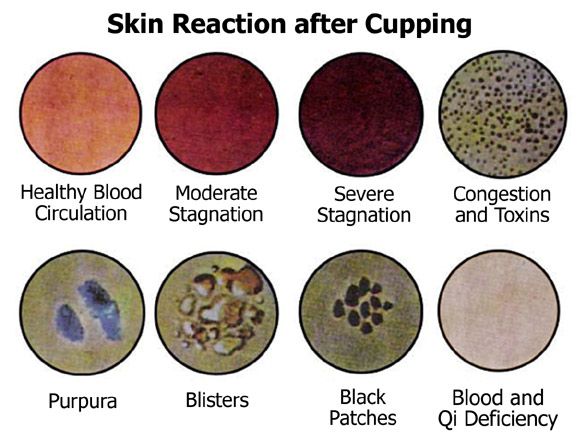
Light Pink
Ms. Mai Sogawa confirms that a slight pink color indicates a healthy state.
Deep Red to Purple
The TCM therapist also believes that deep red to purple indicates that the blood is stagnant.
Purplish to Black
According to Ms. Mai Sogawa, as the color gets darker than purple, the degree of blood stagnation also increases. Blood stagnation is called “blood stasis” in Oriental medicine. It is said that it is better to put it outside because the blood is not in very good condition. There is also a treatment method called “Hijama”, in which the skin is slightly scratched and cupping is applied to drain the blood.
Darks Specks and Black Patches
Ms. Mai Sogawa believes that dark specks and black patches represent the state in which waste products and fatigue are accumulated in the body.
Purpura and Blisters
Blisters are when excess fluid builds up in your body. According to Ms. Mai Sogawa, since water metabolism is not well done, it is good to drain by cupping.
Pale Skin
This is a state in which energy sources such as qi and blood are insufficient. Ms. Mai Sogawa explains that it represents a weak constitution, anemia, and a weakened immune system.
Wrap Up
Cupping improves blood circulation and regulates the autonomic nervous system. Also, unlike massage, cupping pulls the skin (rather than pushing it), so you don’t have to worry about muscle pain caused by regular massage.
Related Reading: Does Cupping Therapy Leave Scars?

Try our Anti-Aging Gua Sha Tool designed to bring out your skin’s natural glow.
Best Gua Sha Product- Anti-Aging: The tool is designed to target 11 specific aging signs such as wrinkles and sagging skin. By following the 7-step routine, users can improve skin firmness and reduce fine lines naturally.
- Enhances Skincare Routine: It works effectively with serums and lotions, boosting absorption and efficacy of skincare products.
- Visible Skin Improvement: Users can expect a smoother complexion, reduced puffiness, and a more youthful appearance.
 P. Sze
P. Sze 















